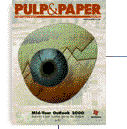|
Serge Sorokin is vice president and operations manager for Champion International in Sartell, Minn.
|

Making safety a core value
The following is excerpted from the keynote address given by Serge Sorokin at the Pulp & Paper Safety Association’s Professional Development Conference. Sorokin received PPSA’s Executive Eagle Award for demonstrating a management philosophy where safety is a top priority.
A daily challenge for mills is to minimize the potential for incidents, and we need to pay attention to the little details in order to avoid the major incidents and events. Mills should work on safety every day by providing clear obtainable goals that measure actual performance and hold individuals accountable for safe results. This idea has been applied to safety and has been ingrained as a basic operating principle at Sartell.
A SIMPLE TEST. At our mill, I expect all employees, including myself, to spend time and personally get involved in safety. A simple test needs to become habit with operational management, as well as every employee, and that is to ask ourselves, sometimes numerous times, “What have I physically done to improve safety in the mill today?”
However, asking the question alone is not enough. Unless some action is involved, little pro-gress will be made. We also need to make sure that everyone is held accountable for this involvement. At Sartell, we have developed action-based programs to help improve our safety performance.
First, we developed short and long term goals for Sartell, looking at our performance and developing a plan of where we wanted to be in a year, in two years, and in three years. Next, we developed and communicated safety principles, responsibilities, and expectations, and we held people accountable for these actions. This information was also communicated to our joint union/management safety action committee.
We now hold supervisors accountable for safety in their areas of responsibility. To help us measure that, we developed safety metrics. These include documented safety feedback sessions. Here, our salaried employees are required to provide safety feedback every month to employees, contractors, and visitors. The outcome from these sessions has included a reinforcement of positive safety practices and an opportunity to correct adverse behaviors. It is also expected that employees document this feedback by entering it into a database set up specifically for this purpose.
Our safety metrics also include adherence to established policies and procedures, participation in monthly safety audits, quality of incident investigations, demonstrations of planning safety into work activities, and participation in millwide safety initiatives. The millwide safety initiatives require completion of at least one safety-related project every year by every employee. All of these metrics are fully in the control of each employee, they are measurable, and they are part of that employee’s annual performance appraisal.
In addition, when we install any major piece of equipment, we assign employees to lead and manage the safety effort throughout the project. These individuals are not solely responsible for safety, but they do help manage safety throughout the project.
RAISING AWARENESS. A great deal of success in safety comes from keeping safety issues and awareness in front of everyone. At Sartell, we institutionalized weekly safety information sessions where we train the workforce on safety requirements, clarify expectations, and communicate performance.
Training is a major focus of our safety program. For this reason, we started Environmental Health and Safety Awareness Days, which are conducted annually. In my opinion, a little creativity in marketing goes a long way toward keeping people’s attention and enthusiasm going, so this event has a fair-like atmosphere, complete with knowledge contests and skits. With it, we have made very important and very serious training fun for the employees. You don’t win anything by making safety training dry and boring. It’s not by accident that we have literally 100% attendance at this training event—and excellent feedback and knowledge retention by our employees.
Over the years, we have also developed an internal safety system evaluation process at Champion that is called P3, which is short for Partnership, Protection, and Process. This formal process helps us measure our safety performance, and it also helps us to identify gaps, correct inefficiencies, and measure overall performance. Our union and management leadership has dedicated time to this P3 process every month at joint meetings.
The bottom line in our safety initiatives—fewer people are getting hurt. From 1997 to 1999, our mill incident rate has significantly declined, and our mill achieved three million safe work hours without a lost time incident. Also, the completion rate of safety related projects that normally would have taken several years are accomplished in months. Safety has truly become an integral part of our business and our core values of the operation.

|




